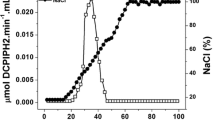Abstract
In the conversion of quinolinic acid to 6-hydroxypicolinic acid by whole cells of Alcaligenes sp. strain UK21, the enzyme reactions involved in the hydroxylation and decarboxylation of quinolinic acid were examined. Quinolinate dehydrogenase, which catalyzes the first step, the hydroxylation of quinolinic acid, was solubilized from a membrane fraction, partially purified, and characterized. The enzyme catalyzed the incorporation of oxygen atoms of H2O into the hydroxyl group. The dehydrogenase hydroxylated quinolinic acid and pyrazine-2,3-dicarboxylic acid to form 6-hydroxyquinolinic acid and 5-hydroxypyrazine-2,3-dicarboxylic acid, respectively. Phenazine methosulfate was the preferred electron acceptor for quinolinate dehydrogenase. 6-Hydroxyquinolinate decarboxylase, catalyzing the nonoxidative decarboxylation of 6-hydroxyquinolinic acid, was purified to homogeneity and characterized. The purified enzyme had a molecular mass of approximately 221 kDa and consisted of six identical subunits. The decarboxylase specifically catalyzed the decarboxylation of 6-hydroxyquinolinic acid to 6-hydroxypicolinic acid, without any co-factors. The N-terminal amino acid sequence was homologous with those of bacterial 4,5-dihydroxyphthalate decarboxylases.




Similar content being viewed by others
References
Arima K, Kobayashi Y (1962) Bacterial oxidation of dipicolinic acid. I. Isolation of microorganisms, their culture conditions and end products. J Bacteriol 84:759–764
Bradford MM (1976) A rapid and sensitive method for the quantitation of microgram quantities of protein utilizing the principle of protein-dye binding. Anal Biochem 72:248–254
Chang HK, Zylstra GJ (1998) Novel organization of the genes for phthalate degradation from Burkholderia cepacia DBO1. J Bacteriol 180:6529–6537
Hirschberg R, Ensign JC (1971) Oxidation of nicotinic acid by a Bacillus species: source of oxygen atoms for the hydroxylation of nicotinic acid and 6-hydroxynicotinic acid. J Bacteriol 108:757–759
Hurh B, Ohshima M, Yamane T, Nagasawa T (1994a) Microbial production of 6-hydroxynicotinic acid, an important building block for the synthesis of modern insecticides. J Ferment Bioeng 77:382–385
Hurh B, Yamane T, Nagasawa T (1994b) Purification and characterization of nicotinic acid dehydrogenase from Pseudomonas fluorescens TN5. J Ferment Bioeng 78:19–26
Kagabu S, Moriya K, Hattori Y (1992) 1-(6-Halonicotinyl)-2-nitromethylene-imidazolidines as potential new insecticide. Biosci Biotechnol Biochem 56:362–363
Kiener A, Glockler R, Heinzmann K (1993) Preparation of 6-oxo-1,6-dihydropyridine-2-carboxylic acid by microbial hydroxylation of pyridine-2-carboxylic acid. J Chem Soc Perkin Trans 1:1201–1202
Kobayashi Y, Arima K (1962) Bacterial oxidation of dipicolinic acid. II. Identification of α-ketoglutaric acid and 3-hydroxydipicolinic acid and some properties of cell-free extracts. J Bacteriol 84:765–771
Kretzer A, Frunzke K, Andreesen JR (1993) Catabolism of isonicotinate by Mycobacterium sp. INA1: extended description of the pathway and purification of the molybdoenzyme isonicotinate dehydrogenase. J Gen Microbiol 139:2763–2772
Laemmli UK (1970) Cleavage of structural proteins during the assembly of the head of bacteriophage T4. Nature 227:680–685
Lee JH, Omori T, Komada T (1994) Identification of the metabolic intermediates of phthalate by Tn5 mutants of Pseudomonas testosteroni and analysis of the 4,5-dihydroxyphthalate decarboxylases gene. J Ferment Bioeng 77:583–590
Moriya K, Shibuya K, Hattori Y, Tsuboi S, Shiokawa K, Kagabu S (1993) Structural modification of the 6-chloropyridyl moiety in the imidacloprid skeleton activity. Biosci Biotechnol Biochem 57:127–128
Nagasawa T, Hurh B, Yamane T (1994) Production of 6-hydroxynicotinic acid from nicotinic acid by resting cells of Pseudomonas fluorescens TN5. Biosci Biotechnol Biochem 58:665–668
Nagel M, Andreesen JR (1990) Purification and characterization of the molybdoenzymes nicotinate dehydrogenase and 6-hydroxynicotinate dehydrogenase from Bacillus niacini. Arch Microbiol 154:605–613
Nakano H, Wieser M, Hurh B, Kawai T, Yoshida T, Yamane T, Nagasawa T (1999) Purification, characterization and gene cloning of 6-hydroxynicotinate 3-monooxygenase from Pseudomonas fluorescens TN5. Eur J Biochem 260:120–126
Nomura Y, Nakagawa M, Ogawa N, Harashima S, Oshima Y (1992) Genes in PHT plasmid encoding the initial degradation pathway of phthalate in Pseudomonas putida. J. Ferment Bioeng 74:333–344
Omura H, Wieser M, Nagasawa T (1998) Pyrrole-2-carboxylate decarboxylase from Bacillus megaterium PYR2910, an organic-acid-requiring enzyme. Eur J Biochem 253:480–484
Parschat T, Canne C, Hüttermann J, Kappl R, Fetzner S (2001) Xanthine dehydrogenase from Pseudomonas putida 86: specificity, oxidation-reduction potentials of its redox-active centers, and first EPR characterization. Biochim Biophys Acta 1544:151–165
Pujar BG, Ribbons DW (1985) Phthalate metabolism in Pseudomonas fluorescens PHK: purification and properties of 4,5-dihydroxyphthalate decarboxylase. Appl Environ Microbiol 49:374–376
Siegmund I, Koenig K, Andreesen JR (1990) Molybdenum involvement in aerobic degradation of picolinic acid by Arthrobacter picolinophilus. FEMS Microbiol Lett 67:281–284
Singh RP, Shukla OP (1986) Isolation, characterization and metabolic activities of Bacillus brevis degrading isonicotinic acid. J Ferment Biotechnol 64:109–117
Slieman TA, Nicholson W (2001) Role of dipicolinic acid in survival of Bacillus subtilis spores exposed to artificial and solar UV radiation. Appl Environ Microbiol 67:1274–1279
Tate RL, Ensign JC (1974) Picolinic acid hydroxylase of Arthrobacter picolinophilus. Can J Microbiol 20:695–702
Uchida A, Ogawa M, Yoshida T, Nagasawa, T (2003) Regioselective hydroxylation of quinolinic acid, lutidinic acid and isocinchomeronic acid by resting cells of pyridine dicarboxylic acid-degrading microorganisms. Appl Microbiol Biotechnol (in press)
Ueda M, Sashida R (1998) Microbial production of 2-hydroxynicotinic acid from nicotinic acid by intact cells of MIC3289. J Mol Catal B 4:199–204
Wieser M, Fujii N, Yoshida T, Nagasawa T (1998) Carbon dioxide fixation by reversible pyrrole-2-carboxylate decarboxylase from Bacillus megaterium PYR2910. Eur J Biochem 257:4405–499
Yasuda M, Sakamoto T, Sashida T, Ueda M, Morimoto T, Nagasawa T (1995) Microbial hydroxylation of 3-cyanopyridine to 3-cyano-6-hydroxypyridine. Biosci Biotechnol Biochem 59:572–575
Yoshida T, Fujita K, Nagasawa T (2002) Novel reversible Indole-3-carboxylate decarboxylase catalyzing nonoxidative decarboxylation. Biosci Biotechnol Biochem 66:2388–2394
Acknowledgements
We would like to thank Dr. Koichi Mitsukura for technical assistance in the isolation and analysis of reaction products.
Author information
Authors and Affiliations
Corresponding author
Rights and permissions
About this article
Cite this article
Uchida, A., Ogawa, M., Yoshida, T. et al. Quinolinate dehydrogenase and 6-hydroxyquinolinate decarboxylase involved in the conversion of quinolinic acid to 6-hydroxypicolinic acid by Alcaligenes sp. strain UK21. Arch Microbiol 180, 81–87 (2003). https://doi.org/10.1007/s00203-003-0573-0
Received:
Revised:
Accepted:
Published:
Issue Date:
DOI: https://doi.org/10.1007/s00203-003-0573-0




